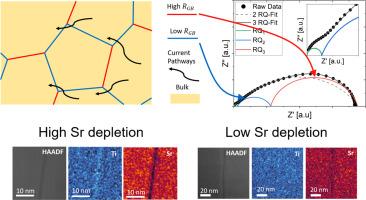当前位置:
X-MOL 学术
›
Acta Mater.
›
论文详情
Our official English website, www.x-mol.net, welcomes your
feedback! (Note: you will need to create a separate account there.)
Non-Arrhenius grain growth in SrTiO3: Impact on grain boundary conductivity and segregation
Acta Materialia ( IF 8.3 ) Pub Date : 2024-11-10 , DOI: 10.1016/j.actamat.2024.120560 M. Pascal Zahler, Dylan Jennings, Olivier Guillon, Wolfgang Rheinheimer
Acta Materialia ( IF 8.3 ) Pub Date : 2024-11-10 , DOI: 10.1016/j.actamat.2024.120560 M. Pascal Zahler, Dylan Jennings, Olivier Guillon, Wolfgang Rheinheimer

|
In this study, a correlation between the conductivity, space charge layers, solute drag and non-Arrhenius grain growth in SrTiO3 was investigated. Strontium titante is known for its non-Arrhenius grain growth where grain growth rates decrease by orders of magnitude with increasing temperatures between 1350 °C and 1425 °C. Here, undoped SrTiO3 was sintered and annealed at temperatures below and above the grain growth transition. The influence of the annealing temperature and time on the conductivity and space charge layers at grain boundaries (GBs) in SrTiO3 was investigated by electrochemical impedance spectroscopy (EIS). STEM-EDS analysis indicates the presence of GBs with qualitative different cationic segregation in SrTiO3. A distortion of the GB semi-circle in the impedance plots was found which was attributed to the presence of multiple GB types with different electric properties and space charge layers. The presence of two GB types as indicated by impedance analysis corresponds well with previous results, where solute drag and segregation was supposed to cause the non-Arrhenius grain growth behavior of SrTiO3.
中文翻译:

SrTiO3 中的非 Arrhenius 晶粒生长:对晶界电导率和偏析的影响
在这项研究中,研究了 SrTiO3 中电导率、空间电荷层、溶质阻力和非 Arrhenius 晶粒生长之间的相关性。钛锶以其非 Arrhenius 晶粒生长而闻名,其中晶粒生长速率随着 1350 °C 至 1425 °C 之间温度的升高而下降几个数量级。 在这里,未掺杂的 SrTiO3 在低于和高于晶粒生长转变的温度下烧结和退火。采用电化学阻抗谱 (EIS) 研究了退火温度和时间对 SrTiO3 晶界 (GBs) 电导率和空间电荷层的影响。STEM-EDS 分析表明 SrTiO3 中存在具有定性不同阳离子分离的 GB。在阻抗图中发现 GB 半圆失真,这归因于存在具有不同电特性和空间电荷层的多种 GB 类型。阻抗分析表明存在两种 GB 类型与之前的结果非常吻合,其中溶质阻力和偏析被认为会导致 SrTiO3 的非 Arrhenius 晶粒生长行为。
更新日期:2024-11-10
中文翻译:

SrTiO3 中的非 Arrhenius 晶粒生长:对晶界电导率和偏析的影响
在这项研究中,研究了 SrTiO3 中电导率、空间电荷层、溶质阻力和非 Arrhenius 晶粒生长之间的相关性。钛锶以其非 Arrhenius 晶粒生长而闻名,其中晶粒生长速率随着 1350 °C 至 1425 °C 之间温度的升高而下降几个数量级。 在这里,未掺杂的 SrTiO3 在低于和高于晶粒生长转变的温度下烧结和退火。采用电化学阻抗谱 (EIS) 研究了退火温度和时间对 SrTiO3 晶界 (GBs) 电导率和空间电荷层的影响。STEM-EDS 分析表明 SrTiO3 中存在具有定性不同阳离子分离的 GB。在阻抗图中发现 GB 半圆失真,这归因于存在具有不同电特性和空间电荷层的多种 GB 类型。阻抗分析表明存在两种 GB 类型与之前的结果非常吻合,其中溶质阻力和偏析被认为会导致 SrTiO3 的非 Arrhenius 晶粒生长行为。


















































 京公网安备 11010802027423号
京公网安备 11010802027423号